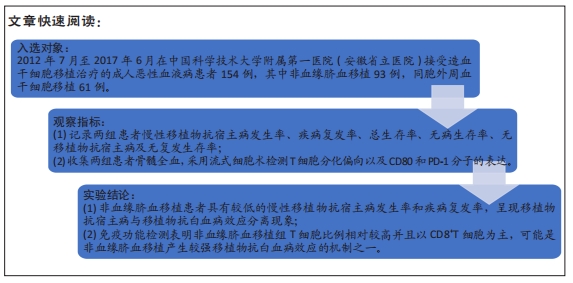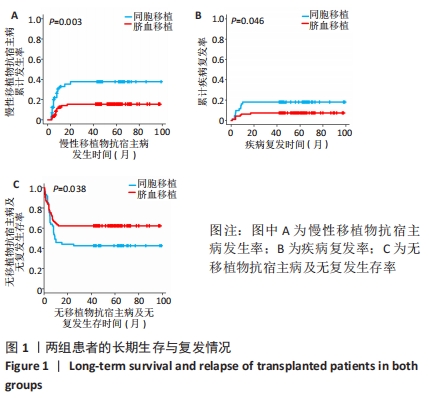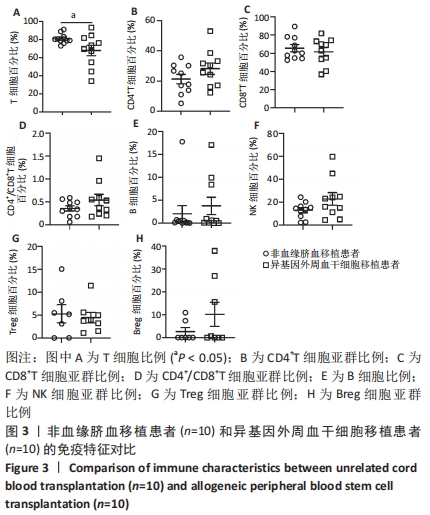[1] ADACHI Y, UKAI S, SAGOU K, et al. Promising Outcome of Umbilical Cord Blood Transplantation in Patients with Multiple Comorbidities. Biol Blood Marrow Transplant. 2018;24(7):1455-1462.
[2] THANGAVELU G, DU J, PAZ KG, et al. Inhibition of inositol kinase B controls acute and chronic graft-versus-host disease. Blood. 2020; 135(1):28-40.
[3] ALYEA EP, DEANGELO DJ, MOLDREM J, et al. NCI First International Workshop on The Biology, Prevention and Treatment of Relapse after Allogeneic Hematopoietic Cell Transplantation: report from the committee on prevention of relapse following allogeneic cell transplantation for hematologic malignancies. Biol Blood Marrow Transplant. 2010;16(8):1037-1069.
[4] CHOI J, COOPER ML, STASER K, et al. Baricitinib-induced blockade of interferon gamma receptor and interleukin-6 receptor for the prevention and treatment of graft-versus-host disease. Leukemia. 2018; 32(11):2483-2494.
[5] LI D, LI X, LIAO L, et al. Unrelated cord blood transplantation versus haploidentical transplantation in adult and pediatric patients with hematological malignancies-A meta-analysis and systematic review. Am J Blood Res. 2020;10(1):1-10.
[6] CASSADY K, MARTIN PJ, ZENG D. Regulation of GVHD and GVL Activity via PD-L1 Interaction With PD-1 and CD80. Front Immunol. 2018;9: 3061.
[7] DEKKER L, DE KONING C, LINDEMANS C, et al. Reconstitution of T Cell Subsets Following Allogeneic Hematopoietic Cell Transplantation. Cancers (Basel). 2020;12(7):1974.
[8] TAKAMI A. Hematopoietic stem cell transplantation for acute myeloid leukemia. Int J Hematol. 2018;107(5):513-518.
[9] GRAGERT L, EAPEN M, WILLIAMS E, et al. HLA match likelihoods for hematopoietic stem-cell grafts in the U.S. registry. N Engl J Med. 2014; 371(4):339-348.
[10] KANAKRY CG, FUCHS EJ, LUZNIK L. Modern approaches to HLA-haploidentical blood or marrow transplantation. Nat Rev Clin Oncol. 2016;13(2):132.
[11] LIU JH, KANAKRY CG, LUZNIK L. Have haploidentical transplants replaced umbilical cord transplants for acute leukemias? Curr Opin Hematol. 2018;25(2):103-111.
[12] BASHEY A, ZHANG X, JACKSON K, et al. Comparison of Outcomes of Hematopoietic Cell Transplants from T-Replete Haploidentical Donors Using Post-Transplantation Cyclophosphamide with 10 of 10 HLA-A, -B, -C, -DRB1, and -DQB1 Allele-Matched Unrelated Donors and HLA-Identical Sibling Donors: A Multivariable Analysis Including Disease Risk Index. Biol Blood Marrow Transplant. 2016;22(1):125-133.
[13] LUZNIK L, FUCHS EJ. High-dose, post-transplantation cyclophosphamide to promote graft-host tolerance after allogeneic hematopoietic stem cell transplantation. Immunol Res. 2010;47(1-3):65-77.
[14] WU R, MA L. Haploidentical Hematopoietic Stem Cell Transplantation Versus Umbilical Cord Blood Transplantation in Hematologic Malignancies: A Systematic Review and Meta-Analysis. Cell Transplant. 2020;29:963689720964771.
[15] BASHEY A, ZHANG MJ, MCCURDY SR, et al. Mobilized Peripheral Blood Stem Cells Versus Unstimulated Bone Marrow As a Graft Source for T-Cell-Replete Haploidentical Donor Transplantation Using Post-Transplant Cyclophosphamide. J Clin Oncol. 2017;35(26):3002-3009.
[16] RUGGERI A, LABOPIN M, BACIGALUPO A, et al. Bone marrow versus mobilized peripheral blood stem cells in haploidentical transplants using posttransplantation cyclophosphamide. Cancer. 2018;124(7): 1428-1437.
[17] CIUREA SO, AL MALKI MM, KONGTIM P, et al. The European Society for Blood and Marrow Transplantation (EBMT) consensus recommendations for donor selection in haploidentical hematopoietic cell transplantation. Bone Marrow Transplant. 2020;55(1):12-24.
[18] GUPTA AO, WAGNER JE. Umbilical Cord Blood Transplants: Current Status and Evolving Therapies. Front Pediatr. 2020;8:570282.
[19] HWANG WY, SAMUEL M, TAN D, et al. A meta-analysis of unrelated donor umbilical cord blood transplantation versus unrelated donor bone marrow transplantation in adult and pediatric patients. Biol Blood Marrow Transplant. 2007;13(4):444-453.
[20] LIU H, RICH ES, GODLEY L, et al. Reduced-intensity conditioning with combined haploidentical and cord blood transplantation results in rapid engraftment, low GVHD, and durable remissions. Blood. 2011;118(24): 6438-6445.
[21] GLUCKMAN E, RUGGERI A, ROCHA V, et al. Family-directed umbilical cord blood banking. Haematologica. 2011;96(11):1700-1707.
[22] PEFFAULT DE LATOUR R, BRUNSTEIN CG, PORCHER R, et al. Similar overall survival using sibling, unrelated donor, and cord blood grafts after reduced-intensity conditioning for older patients with acute myelogenous leukemia. Biol Blood Marrow Transplant. 2013;19(9): 1355-1360.
[23] LIU HL, SUN ZM, GENG LQ, et al. Similar survival, but better quality of life after myeloablative transplantation using unrelated cord blood vs matched sibling donors in adults with hematologic malignancies. Bone Marrow Transplant. 2014;49(8):1063-1069.
[24] TAKAHASHI S, OOI J, TOMONARI A, et al. Comparative single-institute analysis of cord blood transplantation from unrelated donors with bone marrow or peripheral blood stem-cell transplants from related donors in adult patients with hematologic malignancies after myeloablative conditioning regimen. Blood. 2007;109(3):1322-1330.
[25] JACOBSON CA, TURKI AT, MCDONOUGH SM, et al. Immune reconstitution after double umbilical cord blood stem cell transplantation: comparison with unrelated peripheral blood stem cell transplantation. Biol Blood Marrow Transplant. 2012;18(4):565-574.
[26] SCHOEMANS H, THEUNISSEN K, MAERTENS J, et al. Adult umbilical cord blood transplantation: a comprehensive review. Bone Marrow Transplant. 2006;38(2):83-93.
[27] MILANO F, EMERSON RO, SALIT R, et al. Impact of T Cell Repertoire Diversity on Mortality Following Cord Blood Transplantation. Front Oncol. 2020;10:583349.
[28] BHATT ST, BEDNARSKI JJ. Immune Reconstitution in Pediatric Patients Following Hematopoietic Cell Transplant for Non-malignant Disorders. Front Immunol. 2020;11:1988.
[29] HIWARKAR P, QASIM W, RICCIARDELLI I, et al. Cord blood T cells mediate enhanced antitumor effects compared with adult peripheral blood T cells. Blood. 2015;126(26):2882-2891.
[30] MILANO F, GOOLEY T, WOOD B, et al. Cord-Blood Transplantation in Patients with Minimal Residual Disease. N Engl J Med. 2016;375(10): 944-953.
[31] TONG J, XUAN L, SUN Y, et al. Umbilical Cord Blood Transplantation without Antithymocyte Globulin Results in Similar Survival but Better Quality of Life Compared with Unrelated Peripheral Blood Stem Cell Transplantation for the Treatment of Acute Leukemia-A Retrospective Study in China. Biol Blood Marrow Transplant. 2017;23(9):1541-1548.
[32] 郑昌成,朱小玉,汤宝林,等.非血缘脐血移植与HLA相合同胞外周血干细胞移植治疗成人恶性血液病的对比研究[J].中华血液学杂志,2017,38(8):673-679.
[33] POLITIKOS I, BOUSSIOTIS VA. The role of the thymus in T-cell immune reconstitution after umbilical cord blood transplantation. Blood. 2014; 124(22):3201-3211.
[34] ZHENG CC, ZHU XY, TANG BL, et al. Clinical separation of cGvHD and GvL and better GvHD-free/relapse-free survival (GRFS) after unrelated cord blood transplantation for AML. Bone Marrow Transplant. 2017; 52(1):88-94.
[35] ZEISER R, BLAZAR BR. Acute Graft-versus-Host Disease - Biologic Process, Prevention, and Therapy. N Engl J Med. 2017;377(22):2167-2179.
[36] HOLTAN SG, DEFOR TE, LAZARYAN A, et al. Composite end point of graft-versus-host disease-free, relapse-free survival after allogeneic hematopoietic cell transplantation. Blood. 2015;125(8):1333-1338.
[37] LAUGHLIN MJ, EAPEN M, RUBINSTEIN P, et al. Outcomes after transplantation of cord blood or bone marrow from unrelated donors in adults with leukemia. N Engl J Med. 2004;351(22):2265-2275.
[38] PARK BG, PARK CJ, JANG S, et al. Reconstitution of lymphocyte subpopulations after hematopoietic stem cell transplantation: comparison of hematologic malignancies and donor types in event-free patients. Leuk Res. 2015;39(12):1334-1341.
[39] WALLER EK, LOGAN BR, FEI M, et al. Kinetics of immune cell reconstitution predict survival in allogeneic bone marrow and G-CSF-mobilized stem cell transplantation. Blood Adv. 2019;3(15):2250-2263.
[40] TIAN DM, WANG Y, ZHANG XH, et al. Rapid Recovery of CD3+CD8+ T Cells on Day 90 Predicts Superior Survival after Unmanipulated Haploidentical Blood and Marrow Transplantation. PLoS One. 2016; 11(6):e0156777.
[41] MINCULESCU L, MARQUART HV, RYDER LP, et al. Improved Overall Survival, Relapse-Free-Survival, and Less Graft-vs.-Host-Disease in Patients With High Immune Reconstitution of TCR Gamma Delta Cells 2 Months After Allogeneic Stem Cell Transplantation. Front Immunol. 2019;10:1997.
[42] HIWARKAR P, ADAMS S, GILMOUR K, et al. Cord blood CD8+ T-cell expansion following granulocyte transfusions eradicates refractory leukemia. Blood Adv. 2020;4(17):4165-4174.
[43] NI X, SONG Q, CASSADY K, et al. PD-L1 interacts with CD80 to regulate graft-versus-leukemia activity of donor CD8+ T cells. J Clin Invest. 2017; 127(5):1960-1977.
|





